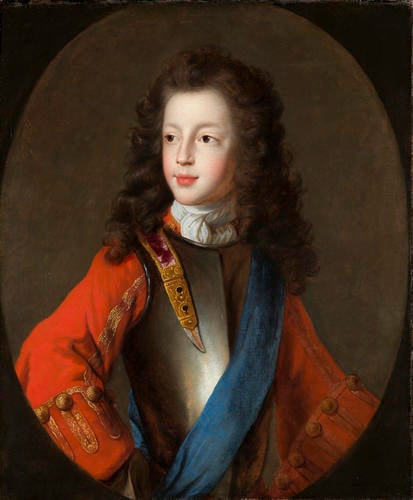Prince James Francis Edward Stuart (1688-1746) c. 1700-05
Oil on canvas | 76.8 x 64.0 cm (support, canvas/panel/stretcher external) | RCIN 401250
-
This portrait is typical of the French Jacobite images produced at the beginning of the eighteenth century. The young Prince James Francis Edward Stuart, Catholic claimant to the English throne, appears in armour with the blue sash of the Order of the Garter. The painting probably dates from around 1701, either slightly before or just after James' father, King James II, died in exile; on his death, Prince James was declared the Jacobite 'James III'. Despite claiming this title, James is shown without a crown or other royal regalia. This decision visually emphasises the Stuarts' stated commitment to a peaceful restoration after the death of Queen Anne (r.1701-14), James II's older daughter and the last surviving Protestant Stuart.
Despite this, the blue Order of the Garter, a longstanding symbol of English royal power, stands out emphatically against the portrait's red and brown palette, emphasising James' royal lineage. Combined with the armour beneath it, it also serves to indicate that – however peaceful and diplomatic he is prepared to be during the reign of his half-sister Anne – James will fight for the crown if necessary. This military undertone became more common in portraits of James after the English Act of Succession of 1701, which specifically excluded him from the English throne in favour of the Protestant Electress Sophia of Hanover.
During the period 1688-1712, when James was living in France under the protection of King Louis XIV (1638-1715), Stuart court portraiture made use of French court artists and portrait conventions. This painting is a product of this relationship: its composition echoes a portrait by the French court painter, François de Troy (1645-1730) of James' young cousin, Phillipe, duc d'Anjou (1683-1746), an engraving of which is now in the Royal Collection (RCIN 606727).
However, the attribution of this portrait of James is uncertain: it has variously been given to de Troy and to his pupil, Alexis-Simon Belle (1674-1734), himself a favourite of the Stuarts in Paris and one of de Troy's studio assistants. Both artists produced a number of similar images of James during this period, but many other versions of this composition are known, reflecting the Jacobite tendency to create reproductions of popular images for distribution amongst their supporters. It seems likely that the composition of this portrait is by de Troy, though the execution is probably either by Belle, or by another of de Troy's studio assistants.
Prince James Francis Edward Stuart (1688-1766) was the only son of the Catholic King James II of England. In 1688, the Protestant-led 'Glorious Revolution' dethroned the king and replaced him with his Protestant daughter, Mary (1662-1694), and her husband William of Orange (1650-1702). Prince James and his father and mother went into exile at the Château Saint-Germain-en-Laye, under the protection of Louis XIV. Later known as the 'Old Pretender', James participated in several unsuccessful plots to reclaim the English throne. In 1712, he left France to establish a court in Rome, where he married Maria Clementina Sobieska (1702-1735). He had two sons: Charles (1720-1788) and Henry (1725-1807), but was never to see a Stuart restoration; the male line died with Henry Stuart in 1807.Provenance
Given to King George V by Queen Mary in 1930
-
Creator(s)
Acquirer(s)
-
Medium and techniques
Oil on canvas
Measurements
76.8 x 64.0 cm (support, canvas/panel/stretcher external)
95.5 x 82.5 x 6.0 cm (frame, external)
Alternative title(s)
Prince James Francis Edward Stuart (1688-1746), son of James VII and II, the Old Pretender










